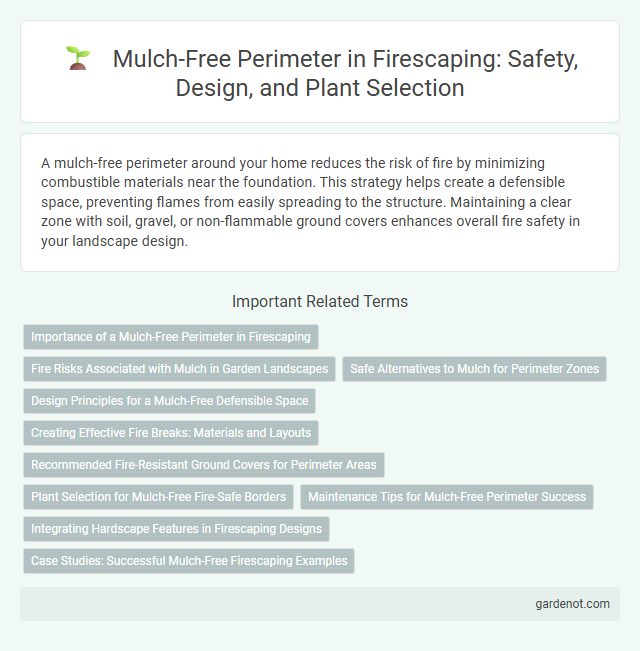A mulch-free perimeter around your home reduces the risk of fire by minimizing combustible materials near the foundation. This strategy helps create a defensible space, preventing flames from easily spreading to the structure. Maintaining a clear zone with soil, gravel, or non-flammable ground covers enhances overall fire safety in your landscape design.
Importance of a Mulch-Free Perimeter in Firescaping
A mulch-free perimeter acts as a crucial firebreak by reducing combustible materials near structures, significantly lowering the risk of wildfire ignition. Maintaining this clear zone disrupts fire's fuel continuity, helping to slow or stop the spread of flames toward buildings. Proper implementation of a mulch-free perimeter is a vital component in effective firescaping strategies for enhancing property protection.
Fire Risks Associated with Mulch in Garden Landscapes
Mulch-free perimeter zones reduce fire risks by eliminating combustible organic materials that can ignite easily near structures. Mulch, especially wood-based types, can act as fuel during wildfires, increasing the likelihood of flame spread and ember ignition. Maintaining bare soil or non-flammable ground covers in these areas significantly enhances fire resistance and protects garden landscapes from fire damage.
Safe Alternatives to Mulch for Perimeter Zones
Mulch-free perimeter zones reduce fire hazards by eliminating flammable materials near structures, promoting defensible space. Safe alternatives include gravel, decomposed granite, or other non-combustible ground covers that prevent weed growth while minimizing fire risk. These materials provide effective moisture retention and soil stability without the volatility associated with traditional mulch.
Design Principles for a Mulch-Free Defensible Space
A mulch-free perimeter enhances fire resistance by reducing flammable materials near structures, prioritizing non-combustible surfaces such as gravel or decorative rock to inhibit fire spread. Strategic plant selection emphasizes low-growing, fire-resistant species spaced adequately to prevent fuel continuity, aligning with defensible space design principles. Incorporating irrigated zones and maintaining clean, hardscape-dominant areas further limits ignition sources, optimizing safety without compromising landscape aesthetics.
Creating Effective Fire Breaks: Materials and Layouts
Creating effective fire breaks involves establishing a mulch-free perimeter using fire-resistant materials such as gravel, crushed stone, or concrete pavers that do not ignite or carry flames. Strategic layouts include wide, uninterrupted zones around structures with compacted surfaces that reduce flammable vegetation and organic debris accumulation. Properly designed fire breaks disrupt wildfire fuel continuity, significantly decreasing the risk of fire spread near homes and critical areas.
Recommended Fire-Resistant Ground Covers for Perimeter Areas
Using fire-resistant ground covers such as creeping sedum, creeping thyme, and buffalo grass in mulch-free perimeter zones effectively reduces wildfire risks while maintaining soil stability. These plants have low resin content and high moisture retention, which inhibit flame spread and protect property boundaries. Incorporating gravel or decomposed granite alongside these ground covers further enhances fire resistance by minimizing combustible materials near structures.
Plant Selection for Mulch-Free Fire-Safe Borders
Choosing fire-resistant plants such as succulents, ornamental grasses, and native species for mulch-free perimeter borders significantly reduces combustible materials near structures. These plants require minimal maintenance while acting as effective natural firebreaks by limiting fuel load. Incorporating stone or gravel in place of mulch further enhances fire safety by preventing ignition and slowing fire spread.
Maintenance Tips for Mulch-Free Perimeter Success
Maintaining a mulch-free perimeter requires regular clearing of dead leaves, debris, and weeds to prevent fuel buildup and reduce wildfire risk. Use gravel or stone ground covers to inhibit weed growth while allowing water penetration and soil stability. Regularly inspect the area for invasive plants and prune nearby vegetation to maintain a defensible space around structures.
Integrating Hardscape Features in Firescaping Designs
Integrating hardscape features such as gravel beds, stone pathways, and concrete patios creates a mulch-free perimeter that significantly reduces fire risk around a property. These non-combustible materials act as effective firebreaks by preventing ignition and slowing the spread of flames in wildfire-prone areas. Using hardscape elements strategically in firescaping designs enhances landscape aesthetics while ensuring maximum defensibility against fire hazards.
Case Studies: Successful Mulch-Free Firescaping Examples
Case studies reveal that mulch-free perimeters significantly reduce fire hazards by creating effective defensible spaces around properties. Properties utilizing gravel, stone, or bare soil instead of mulch have demonstrated enhanced fire resistance and minimized ember ignition risks. These examples underline the effectiveness of mulch-free firescaping in protecting structures and preserving landscape aesthetics.
Mulch-free perimeter Infographic

 gardenot.com
gardenot.com